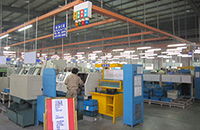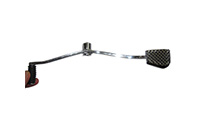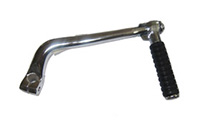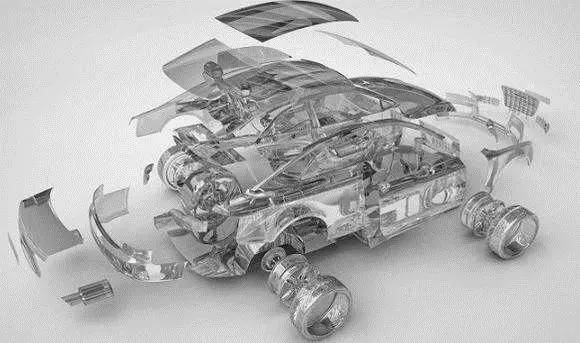- Time of issue:2020-12-07
Trends and Analysis of Auto Parts Industry in 2017
(Summary description)The upstream of the auto parts industry includes steel, plastic, rubber and other production raw materials, and the downstream mainly targets the supporting market of OEMs and the after-sales service market.
There are many industries involved in the upstream
Trends and Analysis of Auto Parts Industry in 2017
(Summary description)The upstream of the auto parts industry includes steel, plastic, rubber and other production raw materials, and the downstream mainly targets the supporting market of OEMs and the after-sales service market.
There are many industries involved in the upstream
- Categories:News
- Author:
- Origin:
- Time of issue:2020-12-07 13:36
- Views:
1. Industrial chain structure of auto parts manufacturing industry
The upstream of the auto parts industry includes steel, plastic, rubber and other production raw materials, and the downstream mainly targets the supporting market of OEMs and the after-sales service market.
There are many industries involved in the upstream, especially steel and other industries occupy an important strategic position in the national economy. The development of the parts industry can effectively drive the development of such industries; from its downstream, the auto parts industry is an important component of the auto industry In part, the auto parts industry is the foundation. Without a strong parts industry as the foundation, there will be no independent, complete and internationally competitive auto industry.
2. The correlation between the auto parts manufacturing industry and the upstream and downstream industries and the value-added space of the industrial chain
From the perspective of upstream industries, the price of raw materials produced in the parts industry is mainly determined by the market prices of bulk commodities such as steel, oil, and natural rubber. In recent years, due to the frequent fluctuations in the prices of iron ore, petroleum, natural rubber and other resource commodities, it has caused certain pressure on the stability of the production and operation of the domestic auto parts industry.
From the perspective of downstream industries, benefiting from the development of the domestic and foreign vehicle industry and the expansion of the consumer market, the domestic auto parts industry shows a good development trend. The downstream customers of domestic parts suppliers are mainly domestic and foreign vehicle manufacturers and their parts suppliers, and the customer concentration is high. Therefore, parts companies are in a relatively weak position in the negotiation with downstream customers. However, for some parts suppliers with leading advantages in a certain market segment, their market position and technological advantages will help to enhance the market voice and bargaining power, so they have the ability to transfer costs downstream.
3. Value-added space and market development of the industrial chain of the auto parts manufacturing industry
The cost of the auto parts manufacturing industry is subject to the upstream industry and its own management level, while the parts required by the downstream auto manufacturers mainly come from fixed suppliers. The largest buyer of auto parts is the auto parts dealer, which is also the main channel for auto parts sales. Profit margins depend on the industry status, competition structure and bargaining power of parts and components companies with downstream industries. A huge "automobile aftermarket" is entering a period of rapid growth, and the auto parts industry has broad prospects.
2. Market environment and influence of auto parts industry
In order to further standardize the automotive aftermarket, improve the overall technology level of the automotive service industry chain, integrate resources from all parties to promote the development of automotive industrialization, and establish a national automotive service industry new technology and new product promotion platform, the National Automotive Service High-tech Industrialization Committee focuses on automotive beauty Decoration and supplies, automotive electronics.
With the improvement of living conditions of our residents, automobiles have become a trend of life and an indispensable means of transportation. Although the country's macroeconomic conditions and regulatory efforts have changed in recent years, and there have been some fluctuations in the growth rate of my country's automobiles, the rigid demand for consumption in the passenger vehicle market still exists, and my country's passenger vehicle consumption will continue to rise steadily for a period of time in the future.
The introduction of more incentive policies for the new energy auto industry in my country will stimulate the rapid increase in the demand for new energy auto parts, and new energy auto parts enterprises will develop rapidly.
According to the China Automobile Industry Information Network, in May 2016, the production and sales of automobiles reached 2,064,900 and 2,091,700, a year-on-year increase of 5.01% and 9.75%. The market of the auto industry has not yet reached saturation, and its expansion will bring further growth of the auto parts industry.
The popularization and application of network technology has had a profound impact on many traditional industries, especially after the State Council proposed the concept of "Internet +". In the field of auto parts, "Internet + parts" is also gaining momentum. Auto parts companies are working to integrate Internet e-commerce channels with traditional channels.
3. China's auto parts industry in recent years
The growth rate of vehicle production and sales continues to slow down, and the downward pressure is increasing, but it is still remarkable; my country's auto parts companies can still maintain sales growth despite the slow growth of operating income, and their performance has risen steadily, slightly better than Vehicle company. However, the risk of continued decline in the net interest rate of the auto parts industry must be taken seriously.
I remember that there was a set of data in the past. In 2015, the scale of my country's export of automobiles and parts increased by about 20% annually; by 2020, the strategic goal of my country's export of automobiles and parts to account for 10% of the world's total auto product trade will be achieved. Therefore, in the long run, there is still a lot of room for growth in the export of my country's automobiles and parts.
Fourth, the global automotive and parts industry
1. Continuous industrial transfer
Emerging auto markets such as China and India have become the largest and most growing auto consumption markets in the world. At the same time, these countries have abundant labor resources, low labor costs, and continuously improving labor quality. With the increasingly fierce competition in the international auto and parts industry, in order to explore emerging markets and effectively reduce production costs, auto and parts companies have begun to accelerate their industrial transfer to China, India, Southeast Asia and other countries and regions.
2. Globalization of auto parts procurement
In the context of global economic integration, the world's major auto companies and parts suppliers, while focusing on their core business and advantageous business, further reduce the self-made rate of auto parts, and turn to the strategy of global procurement. Procurement of auto parts products with comparative advantages within the scope.
3. Systematic development, modular manufacturing, integrated supply
The integration and modularization of the auto parts system is to integrate the functions previously realized by multiple parts into a module assembly through a new design and process, so as to realize the technology of replacing multiple parts by a single module assembly means.
The integration and modularization of auto parts system has many advantages. First, compared with individual parts, the weight of integrated and modular components is lighter, which is conducive to the lightweight of the whole machine, so as to achieve the purpose of energy saving and emission reduction; secondly , the integrated and modular components take up less space, which can optimize the space layout of the whole machine, thereby improving the performance of the whole machine; thirdly, compared with a single component, the integrated and modular components reduce the installation process and improve the performance. Assembly efficiency.
4. Development of new technology for auto parts
As the whole society pays more and more attention to environmental issues, energy saving and environmental protection technology will become the future technology trend of the automobile and parts industry. The development of new energy vehicles represented by fuel cell vehicles and hybrid vehicles is accelerating, and the lightweight design of auto parts, electronic and intelligent design, and auto parts remanufacturing technology are gradually being applied.
Five, domestic auto parts industry trends
New model of production and sales channels:
At present, most of the accessories required by domestic auto manufacturers have their fixed suppliers. The largest buyer of auto parts is auto parts dealers, accounting for more than 80%, and it is also the main channel for auto parts sales. And my country's auto parts dealers are mostly concentrated in the auto parts city. According to statistics, 60% of the parts used in auto maintenance come from the auto parts city.
The domestic automotive aftermarket can be roughly divided into four types of e-commerce models:
Mall e-commerce model
C2B user custom class pattern
B2C+O2O mode
B2B2C+O2O mode
The upstream of the auto parts industry includes steel, plastic, rubber and other production raw materials, and the downstream is mainly aimed at the supporting market of the main engine factory and the after-sales service market.
There are many industries involved in the upstream, especially steel and other industries occupy an important strategic position in the national economy. The development of the parts industry can effectively drive the development of such industries; from its downstream, the auto parts industry is an important component of the auto industry In part, the auto parts industry is the foundation. Without a strong parts industry as the foundation, there will be no independent, complete and internationally competitive auto industry.
The correlation between the auto parts manufacturing industry and the upstream and downstream industries and the value-added space of the industrial chain
From the perspective of upstream industries, the price of raw materials produced in the parts industry is mainly determined by the market prices of bulk commodities such as steel, oil, and natural rubber. In recent years, due to the frequent fluctuations in the prices of iron ore, petroleum, natural rubber and other resource commodities, it has caused certain pressure on the stability of the production and operation of the domestic auto parts industry.
From the perspective of downstream industries, benefiting from the development of the domestic and foreign vehicle industry and the expansion of the consumer market, the domestic auto parts industry shows a good development trend. The downstream customers of domestic parts suppliers are mainly domestic and foreign vehicle manufacturers and their parts suppliers, and the customer concentration is high. Therefore, parts companies are in a relatively weak position in the negotiation with downstream customers. However, for some parts suppliers with leading advantages in a certain market segment, their market position and technological advantages will help to enhance the market voice and bargaining power, so they have the ability to transfer costs downstream.
The value-added space and market development of the industrial chain of the auto parts manufacturing industry
The cost of the auto parts manufacturing industry is subject to the upstream industry and its own management level, while the parts required by downstream auto manufacturers mainly come from fixed suppliers. The largest buyer of auto parts is auto parts dealers, and it is also the main channel for auto parts sales. Profit margins depend on the industry status, competition structure and bargaining power of parts and components companies with downstream industries. A huge "automobile aftermarket" is entering a period of rapid growth, and the auto parts industry has broad prospects.
Auto parts industry market environment and influence
In order to further standardize the automotive aftermarket, improve the overall technology level of the automotive service industry chain, integrate resources from all parties to promote the development of automotive industrialization, and establish a national automotive service industry new technology and new product promotion platform, the National Automotive Service High-tech Industrialization Committee focuses on automotive beauty Decoration and supplies, automotive electronics.
With the improvement of living conditions of Chinese residents, automobiles have become a trend of life and an indispensable means of transportation. Although the country's macroeconomic conditions and regulatory efforts have changed in recent years, and there have been some fluctuations in the growth rate of my country's automobiles, the rigid demand for consumption in the passenger vehicle market still exists, and my country's passenger vehicle consumption will continue to rise steadily for a period of time in the future.
The introduction of more incentive policies for the new energy auto industry in my country will stimulate the rapid increase in the demand for new energy auto parts, and new energy auto parts enterprises will develop rapidly.
According to the China Automobile Industry Information Network, in May 2016, the production and sales of automobiles reached 2,064,900 and 2,091,700, a year-on-year increase of 5.01% and 9.75%. The market of the auto industry has not yet reached saturation, and its expansion will bring further growth of the auto parts industry.
The popularization and application of network technology has had a profound impact on many traditional industries, especially after the State Council proposed the concept of "Internet +". In the field of auto parts, "Internet + parts" is also gaining momentum. Auto parts companies are working to integrate Internet e-commerce channels with traditional channels.
China's auto parts industry in recent years
The growth rate of vehicle production and sales continues to slow down, and the downward pressure is increasing, but it is still remarkable; my country's auto parts companies can still maintain sales growth despite the slow growth of operating income, and their performance has risen steadily, slightly better than Vehicle company. However, the risk of continued decline in the net interest rate of the auto parts industry must be taken seriously.
I remember a set of data in the past. In 2015, the scale of my country's automobile and parts export sales increased by about 20% annually; by 2020, the strategic goal of my country's export of automobiles and parts to account for 10% of the world's total auto product trade will be achieved. Therefore, in the long run, there is still a lot of room for growth in the export of my country's automobiles and parts.
Global Auto and Parts Industry Situation
1. Continuous industrial transfer
Emerging auto markets such as China and India have become the auto consumption markets with the largest market capacity and the most growth in the world. At the same time, these countries have abundant labor resources, low labor costs, and continuous improvement of labor quality. With the increasingly fierce competition in the international auto and parts industry, in order to explore emerging markets and effectively reduce production costs, auto and parts companies have begun to accelerate their industrial transfer to China, India, Southeast Asia and other countries and regions.
2. Globalization of auto parts procurement
In the context of global economic integration, the world's major auto companies and parts suppliers, while focusing on their core business and advantageous business, further reduce the self-made rate of auto parts, and turn to the strategy of global procurement. Procurement of auto parts products with comparative advantages within the scope.
3. Systematic development, modular manufacturing, integrated supply
The integration and modularization of the auto parts system is to integrate the functions previously realized by multiple parts into a module assembly through a new design and process, so as to realize the technology of replacing multiple parts by a single module assembly means.
The integration and modularization of auto parts system has many advantages. First, compared with individual parts, the weight of integrated and modular components is lighter, which is conducive to the lightweight of the whole machine, so as to achieve the purpose of energy saving and emission reduction; secondly , the integrated and modular components take up less space, which can optimize the space layout of the whole machine, thereby improving the performance of the whole machine; thirdly, compared with a single component, the integrated and modular components reduce the installation process and improve the performance. Assembly efficiency.
4. Development of new technologies for auto parts
As the whole society pays more and more attention to environmental issues, energy saving and environmental protection technology will become the future technology trend of the automobile and parts industry. The development of new energy vehicles represented by fuel cell vehicles and hybrid vehicles is accelerating, and the lightweight design of auto parts, electronic and intelligent design, and auto parts remanufacturing technology are gradually being applied. (Source: NetEase)
The first two types of e-commerce models require consumers to have corresponding vehicle or maintenance knowledge. Auto parts are different from other products, and errors in the model of the parts or the corresponding information will lead to deviations in the products. E-commerce plays a great role in disintermediation (B2C for accessories), cost transparency (transparency of accessories and service costs) and user experience improvement, and can create a win-win situation for car owners, parts factories, and repair stations.
Scan the QR code to read on your phone
Other news
© 2020 Taizhou Kinglife-Manufacturers of Automobile Spare Parts Company
















